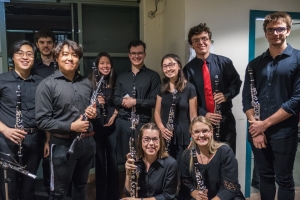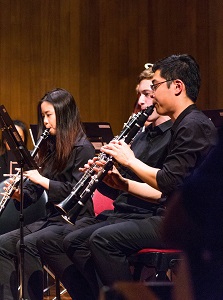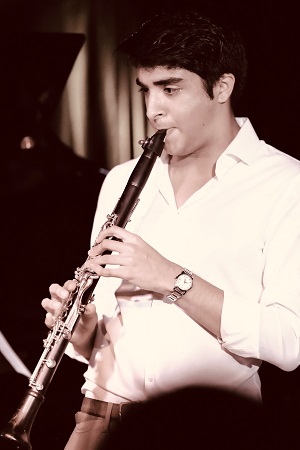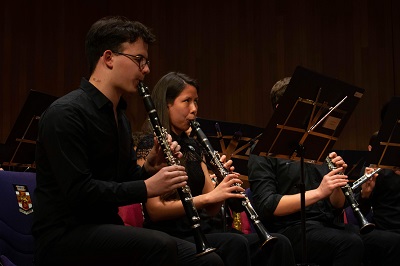So, You're A Clarinetist?

There are over 100 students, staff and community members in our Large Instrumental Music Ensembles at any given time. Each month we will be introducing a new section of our ensembles to you.
UNSW Wind Symphony and UNSW Orchestra have a tightknit team of keen clarinetists who play many different types of clarinet, from the most common B flat clarinet to the bass clarinet, the A clarinet, the Eb clarinet and sometimes even the contrabass clarinet, the contra-alto clarinet, and the alto clarinet!
Gabrielle Goodman is in her fifth year of a Bachelor of Music. This is her second year in UNSW Orchestra and fourth year in UNSW Wind Symphony. In 2021 she is Principal Clarinet in UNSW Orchestra and Concertmaster in UNSW Wind Symphony.
Brian Ee plays the bass clarinet in UNSW Wind Symphony. He is in his first year of a PhD in the School of Medical Sciences at UNSW and previously completed a Bachelor of Advanced Science/Bachelor of Arts (Music) at UNSW in 2020. Brian has been playing clarinet and bass clarinet in the Wind Symphony since 2015, and has also played the clarinet and bass clarinet in the UNSW Orchestra.
Ishaan Vellani is a first year student at UNSW, studying a combined Bachelor of Music (Performance)/Bachelor of Science (Neuroscience). He joined the UNSW Orchestra at the start of 2021, and has really loved being part of the ensemble so far. He has enjoed the opportunity to connect with people outside of his degree.

What types of clarinets do you play and what are the differences?
Gabrielle: I play the Bb clarinet, the standard and most common type, in both UNSW Orchestra and UNSW Wind Symphony
Brian (left): In the Wind Symphony I play the B flat and bass clarinets. The B flat clarinet is the most common type of clarinet and is what most people are familiar with. The bass clarinet is pitched an octave lower than the B flat clarinet, is much bigger and looks a bit like a tenor saxophone. Strangely, bass clarinet music is still written in the treble clef but is played a 9th lower than what is written.
Ishaan: In Orchestra, I play the most popular clarinet - the B-flat clarinet. At school, I also used to play the A clarinet in orchestra, and the E-flat clarinet in the wind band. The A clarinet is an older version of the clarinet, and is a little bit bigger than the normal clarinet. The E-flat clarinet, also known as the piccolo clarinet, is TINY in comparison! While they’re both fun to play, the B-flat clarinet is hands-down my favourite of them all.

What is the role of the clarinet in your ensemble?
Gabrielle: My role as concertmaster in Wind Symphony is to basically lead the orchestra in following the conductor. In our concerts you'd see me getting up to lead the ensemble in the tuning process as well before we start! In the orchestra my role as first clarinet is to lead the clarinet section and work closely with the other wind players (flutes, oboes, and bassoons) to make sure we're all on the same page, working together as a team.
Brian: There are typically three B flat clarinet parts (with three to five players on each part), one to two bass clarinet parts and sometimes an E flat clarinet part in the Wind Symphony. The B flat clarinets can play alto supporting lines and also virtuosic melodic and solo parts. The E flat clarinet can add to the high end and is analogous to the piccolo. The bass clarinet can play different roles – it’s sometimes treated as a low clarinet and plays the bass part of the clarinet choir, and sometimes as a bass woodwind along with the bassoons and baritone saxophone.
Ishaan (right): The clarinet (being the best and most beautiful sounding instrument in the woodwind section, if not the whole orchestra) has one of the most important roles in the ensemble. It blends really nicely with almost any instrument, and it’s also very versatile. As 2nd clarinet, basically my job is to be the Principal’s right hand guy and follow their lead (Gabby is a brilliant leader!), and I am often doubling the 1st part, an octave below. Composers like to use the clarinet in pieces for many reasons - some of these include adding a mellow timbre, providing some harmonic bulk, or to spruce up a string melody. We even get some snazzy solos every once in a while. (See Danzon No.2, Rhapsody in Blue, Pini di Roma as well as countless others.) Basically, the clarinet is there to make anything sound downright AWESOME. No bias here whatsoever…
What kind of music do you like playing on the clarinet?
Gabrielle: I like to play classical musical on the clarinet but over the past few years at UNSW I have explored more experimental/new music avenues for the clarinet and it has been so much fun! My favourite piece to play and listen to would have to be John Ireland's Fantasy-Sonata. It was one of the first solo pieces that I could really pour my heart into and absolutely love playing everytime.
Brian: On the clarinet, I mostly play classical music, although lately I’ve been playing the Copland Clarinet concerto which is somewhere between classical and jazz. I’ve enjoyed listening and watching Michael Lowenstern’s bass clarinet Youtube channel (Earspasm music) – check it out!
Ishaan: I am a classical music fanatic, and there is heaps of incredible classical repertoire for clarinet. In high school, I also developed a real fondness for jazz, and ended up picking up the saxophone to explore that realm of the musical world. While there is a great deal of early jazz stuff for the clarinet, I like to apply the “stay in your lane” principle to my music, and I’ve basically stuck to the classical side of things on clarinet. On that note, there are of course too many favourite pieces to choose from. First and foremost, the Mozart Clarinet Concerto must inevitably make an appearance - not much to say, except that it’s perfection on paper and everyone MUST listen to it… that’s non-negotiable. My favourite piece to play is Göran Fröst’s Klezmer Dances, based on Giora Fiedman’s Let’s Be Happy. It hosts a mammoth armoury of crazy extended techniques, and playing it almost requires 3 lungs! I love it because it turns the clarinet into a living breathing character, and it is the best fun to play.
What can clarinetists expect when they join Wind Symphony or Audition or Orchestra?
Gabrielle (below): The audition process can be a little intimidating but every time I've auditioned, the atmosphere was always chill and friendly. Everyone is so welcoming and keen to make music together - Wind Symphony and Orchestra was really the place where I made legit friends at UNSW. I only joined in my second year and totally regretted not joining in my first, so don't make the same mistake I did!

Brian: You can expect a lot of fun repertoire! We play a whole range of music and there’s something for everyone. I had played mostly classical music before, so the Wind Symphony has been a really nice way to try out something fun and different.
Ishaan: After a pretty relaxed audition, if you’re lucky enough to become a member of the Orchestra, there’s many things to look forward to. As I said before, I’ve thoroughly enjoyed connecting with people from all years (and beyond) in the orchestra, and for this reason I highly recommend joining any uni musical ensemble. Making music is one of the most universal experiences, and it has the power to unify any group of people. Whether you’re a scientist, a poet, a designer, or anything in between, if you love music you will fit right in. As for clarinettists specifically, get ready to join the grooviest section of the orchestra!
Overall, my experience has been a blast. I did heaps of music at school, so it was really refreshing for me to get back into that rhythm. As it was during high school, rehearsals are a great way to escape from the rigours of your degree for a few hours each week. I’ve never seen rehearsals as ‘giving up’ my Tuesday night - it’s a chance for me to take a break, and just play some good music with good friends! I hope to see many new faces next year from all years.
Registrations to audition for UNSW Orchestra or to join UNSW Wind Symphony open in O Week of each term. Check out our UNSW Orchestra page to see which instruments we are currently accepting applications for. Anyone is welcome to join UNSW Wind Symphony.
